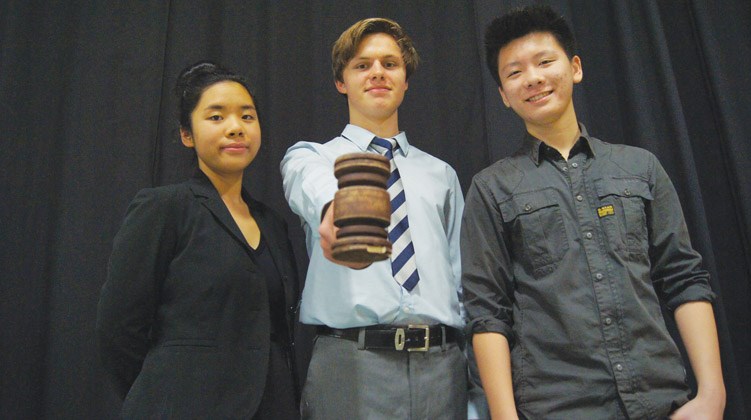About 120 students enrolled in Law 12 at Burnett, McRoberts and Steveston-London secondary schools took part in the second annual Richmond Charter Cases Challenge at Steveston-London.
They debated the merits of past, high-profile Supreme Court of Canada decisions, involving interpretation of the Charter of Rights and Freedoms.
"It's about giving students a better understanding of law, the law profession and the Charter of Rights and Freedoms," said Burnett Law 12 teacher Herj Ghaug. "It gives the students an awareness that in Canadian law there are different perspectives, there's no clear-cut answer."
Over the course of the day, the students were split into teams, each participating in two mock trials. The teams had the chance to be a part of two of either the crown, defence or jury.
During the trials, the defence and crown had an opportunity to present their cases to the jury - representing the nine judges.
The two sides then questioned one another on the merits of the historical decision. The jury decided which side argued its case best, meaning if the students were representing the historical winning side, they needed to argue why their side won in order to win the challenge.
The cases challenged students to look at different moral and philosophical perspectives, noted Drew Arnold, a Law 12 teacher at McRoberts secondary school.
"The fact that they didn't get to choose their side meant that in some cases they had to argue something that, at first, they wouldn't feel comfortable arguing for," said Arnold.
One mock trial looked at the Robert Latimer case that resulted in Latimer, a farmer, being found guilty of murdering his daughter who was suffering from cerebral palsy. Latimer had appealed, claiming his actions were out of mercy.
Another mock trial looked at the Tawney Meiorin decision, where the highest court found the female firefighter had been discriminated against when she was fired for not being able to pass a fitness test.
The challenge was an opportunity for students to gather insightful opinions from others outside of class. "I got a better understanding on the court cases," said Burnett student Larissa Sakumoto. "If you don't know anything about the people you're debating, it's a lot different and you learn more."
Fellow Burnett student Nadia Gonzaga said the challenge helped students think critically.
"When you're put on the side you don't morally agree with it can be challenging to try to defend that," said Gonzaga. "But this challenge helps you do that, it helps you see both sides and that's important in developing debate skills."
The challenge also helped to improve students' speaking skills as they had to stand in front of about 40 other students, many of whom they had never met before.
"It can be nerve-racking, but debating is a good thing. You get to see both sides of the story," said Steveston-London student George Xie.
The challenge was first held last year by Burnett and McRoberts. This year, Steveston-London joined and next year Ghaug says other schools are interested in participating.
Ghaug said because the students became so heavily involved and interested in the day-long debating event, it has taken on a life of its own. He's hoping to procure help from the Justice Education Society of BC to make the debates more formal.
This year, students were asked to wear formal attire, but next year Ghaug is hoping to get legal robes for his students. He's also working on holding the debates inside an actual court room.



